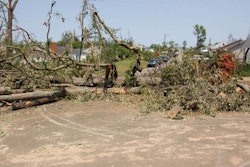Usually a home repair solves a problem or prevents a hazard. When it comes to Arkansas roofs battered by this year’s high winds, storm debris or hail, however, the repair can create a potentially deadly problem.
Toxic carbon monoxide, or CO, an odorless, colorless gas, may be trapped in a home by damaged venting systems, endangering the people and animals that live there, warn officials from the Arkansas Department of Emergency Management (ADEM) and the Federal Emergency Management Agency (FEMA).
Each year more than 400 Americans die from unintentional CO poisoning, while thousands visit emergency rooms and more than 4,000 are hospitalized due to CO-related illness, according to the Centers for Disease Control (CDC).
The chances of exposure increase in a home that has been storm damaged or one in which repairs were not made correctly, say recovery experts from ADEM and FEMA.
Venting systems are designed to channel CO and other possibly dangerous gases from home living spaces to the outdoors. The systems run from a home furnace, water heater, cooking range or other appliances through the attic and the roof into the open air, where the gases harmlessly disperse.
Venting systems can fail, however, if the roof vents are:
- Damaged by hail
- Blocked by storm debris
- Disconnected by high winds or debris carried by the wind
- Attached or installed incorrectly when a home is reroofed or repaired
Arkansans can prevent this potential hazard by following these tips from the Arkansas Department of Health and the CDC:
- After severe weather, visually check flue vent piping from the gas appliances inside the home and the attic to make sure pipes are not disconnected.
- Check the venting on the roof and clear all vents of storm debris to guarantee air flow.
- Never patch a vent pipe with tape, gum or another substance. This kind of patch can cause CO to build up in a home.
- Have repairs made by a licensed plumber or heating and air contractor if problems are noticed.
- Know the proper way to install vent pipes. Horizontal vent pipes to gas-fueled appliances should not be perfectly level. They should slant up slightly as they head toward the outdoors. This helps prevent gases from leaking if the pipes or joints are not fitted properly.
- After a home is reroofed or repaired, bring in a plumber or air and heating contractor to check that venting was installed correctly inside and outside the building.
- Install a carbon monoxide detector in the home, preferably near bedrooms, to alert residents if CO levels rise. A detector is the only way to know when dangerous CO levels are present in a home.
A handout on preventing carbon monoxide poisoning during disaster recovery is available from the Arkansas Department of Health, along with other materials on healthy living, at www.healthy.arkansas.gov. Emergency preparedness information is posted online at www.ready.gov.
For the original FEMA press release, click here








